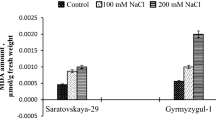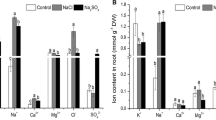Abstract
The separate foliar application of zinc (Zn) and epibrassinolide (EBL) have widely proved tolerance to several abiotic stresses, but their combined effect exposed to oxidative stress is an untouched area of investigation. In order to evaluate the physiological mechanism of salt stress tolerance, a pot experiment was conducted. The results revealed that chlorophyll content, efficiency of photosystem ΙΙ, total leaf area, total biomass, membrane stability index and relative water content decreased under 100 mM NaCl concentration whereas, the foliar application of Zn and EBL alone and in combination increased these parameters. In addition, an increase in accumulation of osmoprotectants and antioxidant enzymes activity was noted under stressed conditions, which was more pronounced in rapeseed plants (Brassica napus L.) treated with combined application of Zn and EBL. Salt stress increased H2O2 and MDA content, while the exogenous application of Zn and EBL decreased these oxidative stress markers. It is concluded that Zinc and EBL reduced toxic effect of salinity, while its combined application showed an additive effect and significantly enhanced salt tolerance.
Similar content being viewed by others
REFERENCES
Munns, R. and Tester, M., Mechanisms of salinity tolerance, Annu. Rev. Plant Biol., 2008, vol. 59, pp. 651–681.
Hayat, Sh., Hasaa, S.A., Yusuf, M., Hayat, Q., and Ahmad, A., Effect of 28-homobrassinolide on photosynthesis, fluorescence and antioxidant system in the presence or absence of salinity and temperature in Vigna radiata, Environ. Exp. Bot., 2010, vol. 69, pp. 105–112.
Mittler, R., Oxidative stress, antioxidants and stress tolerance, Trends Plant Sci., 2002, vol. 7, pp. 405–410.
Fariduddin, Q., Khalil, R.R.A.E., Mir, B.A., Yusuf, M., and Ahmad, A., 24-Epibrassinolide regulates photosynthesis, antioxidant enzyme activities and proline content of Cucumis sativus under salt and/or copper stress, En-viron. Monit. Assess., 2013, vol. 185, pp. 7845–7856.
Cakmak, I., Possible roles of zinc in protecting plant cells from damage by reactive oxygen species, New Phytol., 2000, vol. 146, pp. 185–205.
Waraich, E.A., Amad, R., Ashraf, M.Y., Saifullah, R.A., and Ahmad, M., Improving agricultural water use efficiency by nutrient management in crop plants, Acta Agric. Scand., B: Soil Plant Sci., 2011, vol. 61, pp. 291–304.
Xu, L.H., Wang, W.Y., Guo, J.J., Qin, J., Shi, D.Q., Li, Y.L., and Xu, J., Zinc improves salt tolerance by increasing reactive oxygen species scavenging and reducing Na+ accumulation in wheat seedlings, Biol. Plant., 2014, vol. 58, pp. 751–757.
Jifon, J., Growth environment and leaf anatomy affect nondestructive estimates of chlorophyll and nitrogen in Citrus sp. leaves, J. Am. Soc. Hort. Sci., 2005, vol. 130, pp. 152–158.
Maxwell, K. and Johnson, G.N., Chlorophyll fluorescence—a practical guide, J. Exp. Bot., 2000, vol. 51, pp. 659–668.
Bates, L.S., Waldren, R.P., and Teare, I.D., Rapid determination of free proline for water-stress studies, Plant Soil, 1973, vol. 39, pp. 205–207.
Grieve, C.M. and Grattan, S.R., Rapid assay for determination of water soluble quaternary ammonium compounds, Plant Soil, 1983, vol. 70, pp. 303–307.
Aebi, H., Catalase in vitro, Methods Enzymol., 1984, vol. 105, pp. 121–126.
Mac-Adam, J.W., Nelson, C.J., and Sharp, R.E., Peroxidase activity in the leaf elongation zone of tall fescue. I. Spatial distribution of ionically bound peroxidase activity in genotypes differing in length of the elongation zone, Plant Physiol., 1992, vol. 99, pp. 872–878.
Becana, M., Aparicio-Tejo, P., Irigoyan, J.J., and Sanchez-Diaz, M., Some enzymes of hydrogen peroxide metabolism in leaves and root nodules of Medicago sativa, Plant Physiol., 1986, vol. 82, pp. 1169–1171.
Heath, R.L. and Packer, L., Photoperoxidation in isolated chloroplasts. I. Kinetics and stoichiometry of fatty acid peroxidation, Arch. Biochem. Biophys., 1968, vol. 125, pp. 189–198.
Zaho, S.J., Xu, C.C., Zou, Q., and Meng, Q.W., Improvements of the method for measurement of malondialdehyde in plant tissue, Plant Physiol. Commun., 1994, vol. 30, pp. 207–210.
Lutts, S., Kinet, J.M., and Bouharmont, J., NaCl-induced senescence in leaves of rice (Oryza sativa L.) cultivars differing in salinity resistance, Ann. Bot., 1996, vol. 78, pp. 389–398.
Rossi, L., Zhang, W., Lombardini, L., and Ma, X., The impact of cerium oxide nano particles on the salt stress responses of Brassica napus L., Environ. Pollut., 2016, vol. 219, pp. 28–36.
Ahmad, P., Ahanger, M.A., Alyemeni, M.N., Wijaya, L., Egamberdieva, D., Bhardwaj, R., and Ashraf, M., Zinc application mitigates the adverse effects of NaCl stress on mustard [Brassica juncea (L.) Czern & Coss] through modulating compatible organic solutes, antioxidant enzymes, and flavonoid content, J. Plant Interact., 2017, vol. 12, pp. 429–437.
Kaur, S.K., Handa, N., Bali, S., Arora, S., Sharma, A., Kaur, R., and Bhardwaj, R., Modulation of antioxidative defense expression and osmolyte content by co-application of 24-epibrassinolide and salicylic acid in Pb exposed Indian mustard plants, Ecotoxicol. Environ. Saf., 2018, vol. 147, pp. 382–393.
Acosta-Motos, J.R., Ortuño, M.F., Bernal-Vicente, A., Diaz-Vivancos, P., Sanchez-Blanco, M.J., and Hernandez, J.A., Plant responses to salt stress: adaptive mechanisms, Agronomy, 2017, vol. 7, pp. 1–38.
Ashraf, M. and Harris, P.J.C., Photosynthesis under stressful environments: an overview, Photosynthetica, 2013, vol. 51, pp. 163–190.
Kapotis, G., Zervoudakis, G., Veltsistas, T., and Salahas, G., Comparison of chlorophyll meter readings with leaf chlorophyll concentration in Amaranthus v-litus: correlation with physiological processes, Russ. J. Plant Physiol., 2003, vol. 50, pp. 395–397.
Weisany, W., Sohrabi, Y., Heidari, G., Siosemardeh, A., and Ghassemi-Golezani, K., Physiological responses of soybean (Glycine max L.) to zinc application under salinity stress, Aust. J. Crop Sci., 2011, vol. 5, pp. 1441–1447.
Jan, A.U., Hadi, F., Midrarullah Nawaz, M.A., and Rahman, K., Potassium and zinc increase tolerance to salt stress in wheat (Triticum aestivum L.), Plant Physiol. Biochem., 2017, vol. 116, pp. 139–149.
Gao, S., Ouyang, C., Wang, S., Xu, Y., Tang, L., and Chen, F., Effects of salt stress on growth, antioxidant enzyme and phenylalanine ammonia-lyase activities in Jatropha curcas L. seedlings, Plant Soil Environ., 2008, vol. 54, pp. 374–381.
Gill, S.S. and Tuteja, N., Reactive oxygen species and antioxidant machinery in abiotic stress tolerance in crop plants, Plant Physiol. Biochem., 2010, vol. 48, pp. 909–930.
Ahammed, G.J., Ruan, Y.P., Zhou, J., Xia, X.J., Shi, K., Zhou, Y.H., and Yu, J.Q., Brassinosteroid alleviates polychlorinated biphenyls-induced oxidative stress by enhancing antioxidant enzymes activity in tomato, Chemosphere, 2013, vol. 90, pp. 2645–2653.
Sharma, A., Kumar, V., Kanwar, M.K., Thukral, A.K., and Bhardwaj, R., Ameliorating imidacloprid induced oxidative stress by 24-epibrassinolide in Brassica juncea L., Russ. J. Plant Physiol., 2017, vol. 64, pp. 509–517.
Author information
Authors and Affiliations
Corresponding author
Additional information
The article is published in the original.
Abbreviations: CAT—catalase; EBL—24-epibrassinolide; EC— electrical conductivity; Fv/Fm —maximal quantum yield of PSII photochemistry; HSD—honest significant difference; MLR— multiple linear regression; MSI—membrane stability index; POX—peroxidase; RWC—relative water content; SOD— superoxide dismutase; SPAD-502—portable chlorophyll meter.
Rights and permissions
About this article
Cite this article
Mokari-Firuzsalari, S., Khomari, S., Seyed-Sharifi, R. et al. The Combined Influence of Zinc and Epibrassinolide Increase Tolerance to Salt Stress in Brassica napus L.. Russ J Plant Physiol 66, 240–249 (2019). https://doi.org/10.1134/S1021443719020092
Received:
Revised:
Accepted:
Published:
Issue Date:
DOI: https://doi.org/10.1134/S1021443719020092




